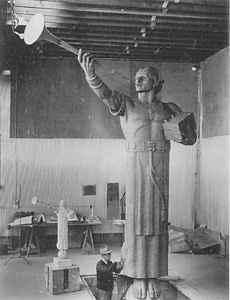 He has a secret, you know, a detail not mentioned in any of the many articles descriptive of the Los Angeles Temple, or in J. Michael Hunter’s excellent summary of Angel Moroni statues in the November 2000 Ensign article. It’s a detail revealed by sculptor Millard F. Malin to fellow artist Jack Sears in a 1956 interview regarding the modeling and casting of the angel that now stands atop the Los Angeles Temple.
He has a secret, you know, a detail not mentioned in any of the many articles descriptive of the Los Angeles Temple, or in J. Michael Hunter’s excellent summary of Angel Moroni statues in the November 2000 Ensign article. It’s a detail revealed by sculptor Millard F. Malin to fellow artist Jack Sears in a 1956 interview regarding the modeling and casting of the angel that now stands atop the Los Angeles Temple.
Millard Fillmore Malin (1891-1974) was born in Salt Lake City. He served a mission to New Zealand commencing when he was only 17 years old. He attended the University of Utah upon his return, studying human anatomy at the medical school and drawing under the Utah artist Edwin Evans, but he dropped out before graduation in order to work and save money for his ambition to study art in New York City. He succeeded in that goal, studying in New York chiefly under the sculptor Herman A. MacNeil. While he was still a student there, he was hired by Gutzon Borglum – best known as sculptor of Mount Rushmore, and born in Idaho to Mormon parents who soon left Mormonism and moved to the Midwest – to assist him in creation of the monument at Stone Mountain, Georgia.
Malin returned to Salt Lake in the mid-1920s and opened his own art studio, teaming with close friend Edward O. Anderson. In the 1940s, Anderson became one of the Church’s chief architects, designing the temples in London, Switzerland, and Los Angeles, for all of which (as well as the temple in New Zealand) Malin contributed sculpture (in most cases the oxen supporting the baptismal font). Malin’s work appears in other places around Utah, in the form of various outdoor monuments, and in Indian busts decorating the interior of the Capitol building.
 In 1951, Malin was commissioned by the Church to sculpt the statue of the Angel Moroni for the new Los Angeles Temple. The model he designed is a more masculine figure than the Dallin statue on the Salt Lake Temple, and was heavily influenced, Malin said, by the drawings of Arnold Friberg – certainly the angel’s broad chest, muscular arms, and vaguely Aztec clothing is reminiscent of the familiar Friberg style. Torlief S. Knaphus, who sculpted his own Angel Moroni for the Cumorah monument, and artists Maurice Brooks and Elbert Porter also assisted Malin in designing and constructing the clay model.
In 1951, Malin was commissioned by the Church to sculpt the statue of the Angel Moroni for the new Los Angeles Temple. The model he designed is a more masculine figure than the Dallin statue on the Salt Lake Temple, and was heavily influenced, Malin said, by the drawings of Arnold Friberg – certainly the angel’s broad chest, muscular arms, and vaguely Aztec clothing is reminiscent of the familiar Friberg style. Torlief S. Knaphus, who sculpted his own Angel Moroni for the Cumorah monument, and artists Maurice Brooks and Elbert Porter also assisted Malin in designing and constructing the clay model.
When it came time to prepare the full 15′ 5-1/2″ statue of gilded cast aluminum, Malin constructed a temporary studio on the grounds of a concrete plant in Salt Lake City. There he erected a 1,500-pound steel armature to support the pliable material out of which he would sculpt the full-size model. A full two tons of the modeling compound Plastilina was required for the heroic-sized figure.
One frequent visitor to Malin’s studio was an old friend, the legendary New Zealand missionary and now apostle Matthew Cowley. Of Elder Cowley’s visits Malin wrote, “He has shown a great interest in this statue and has been most appreciative toward all who have contributed to its successful completion.”
The cornerstone of the Los Angeles Temple was laid in December 1953, while Malin’s statue was still in its clay form, nearly ready for casting in aluminum. Elder Cowley visited Malin’s studio again on the day before he left to attend the cornerstone ceremony. Elder Cowley examined the completed model from all sides. When Malin asked him what he thought, he said, “It is superb! I like it – like everything about it.” Pleased, Malin handed Elder Cowley a modeling tool and invited him to “sign” the clay figure. Elder Cowley did so, carving “MC” into the lower edge of the angel’s robe, in back. He thanked Malin, wished him well, and left for his appointment in Los Angeles.
Elder Cowley died of a heart attack on December 13, 1953, while he was still in Los Angeles for the cornerstone-laying ceremony.
Early in 1954, Malin coated his clay figure with a thousand pounds of plaster of paris to make the molds to cast the completed statue. The molds were sent to a bronze foundry in New York, which cast the statue in five parts, then welded them together in one. They then coated the statue with 22-carat gold leaf, and the statue was shipped to Los Angeles, where it was hoisted atop the new temple.
At every step – in the making of the molds, in the casting and welding and buffing, in the final gold leafing – Malin was careful to preserve the carved “MC” at the bottom of Moroni’s robe. It is there today, a quiet and unremarked tribute to Matthew Cowley, a friend and supporter of the sculptor.
Continue reading at the original source →



